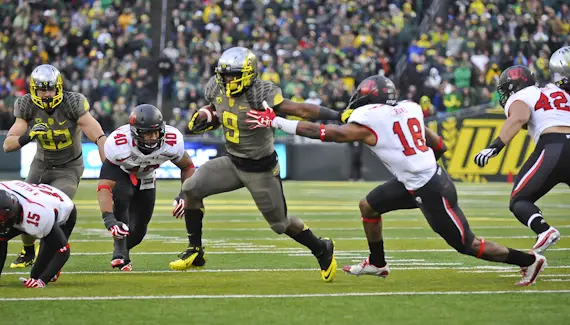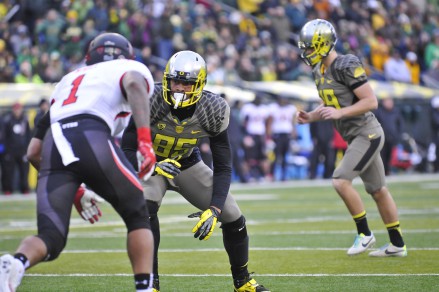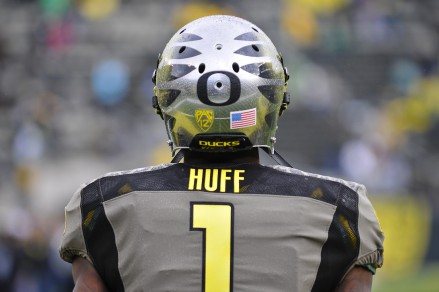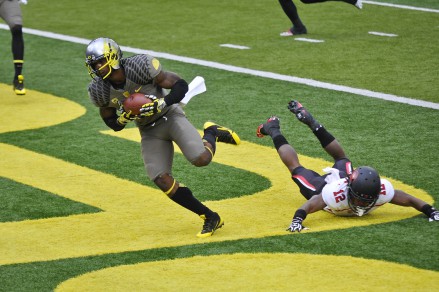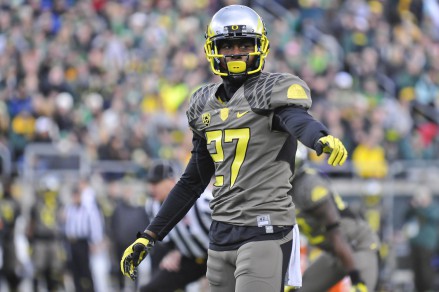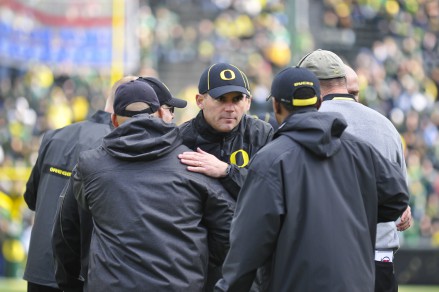Kevin Cline
This has been a year of firsts for Mark Helfrich, and after his first loss as a head coach, Saturday’s game against Utah was another: preparing the Ducks to respond to adversity. And respond Oregon did.
It wasn’t much of a surprise that the Duck came out a bit flat, after all, just nine days prior they had their championship dreams all but crushed. After a first half that didn’t go their way, it would have been easy for the players to lose focus and let a tough loss derail a once-promising season. Instead, the team emerged from halftime noticeably fired up, and returned to their old, ruthless ways.
Thanks to one of Oregon’s sharpest halves of the season, the Ducks overwhelmed the Utah Utes 44-21 in a game that wasn’t as close as the 23-point margin suggests. Early in the 2nd quarter, Oregon took control of the game, taking out the frustration of the Stanford loss on a helpless Utah team. Ironically, Stanford’s lone loss of the season (before last night) came against Utah, giving the Ducks a chance to reclaim some of their lost pride and remind the nation that they’re still among college football’s elite.
Admittedly, the 1st half wasn’t a thing of beauty. The Ducks came out of the gates with some conservative play-calling, but after a bad decision by Utah’s backup QB Adam Schulz, a sophomore making his first start, the Ducks struck quickly. Taking advantage of Terrance Mitchell’s interception, Mariota pitched two quick passes to Pharaoh Brown and De’Anthony Thomas, resulting in the first points of the game.
On Oregon’s next drive, the Matt Wogan era began, as the recently-named starting place-kicker hit a 31-yard field goal. It’s hard to remember any crowd getting as excited about a short, 1st-quarter field goal.
The defense continued to play well behind a front seven that looked significantly better playing against an offensive line that wasn’t the nation’s best. Despite multiple opportunities to put the game out of reach early, the Oregon offense sputtered due to an inability to run the ball effectively and some clearly conservative play-calls.
Toward the end of the half, a grind-it-out Utah drive all-too-reminiscent of the Stanford game led to a 34-yard play-action touchdown pass, bringing Utah to within just three points. Oregon immediately answered with a three-play, 45-second drive that included a beautiful swing pass to Bralon Addison. The 57-yard reception set up a 5-yard touchdown pass to Josh Huff.
After an uneventful end to the 1st half, the Ducks came out of halftime on a mission. Up only 17-7, Oregon gave up an early touchdown after a highly suspect (see: terrible) 3rd-down pass interference penalty on Terrance Mitchell that would’ve capped a 3-and-out to open the half. Nonetheless, Oregon immediately responded with a 95-yard De’Anthony Thomas kickoff return for a touchdown.
Things didn’t go well for Utah from that point forward. After the Duck D forced a three-and-out, Oregon’s offense took advantage and methodically marched down the field for a touchdown, making it a three-score game.
The defense continued to play well, forcing four three-and-outs in the 2nd half. Meanwhile, Oregon’s running game finally got going. Behind two Byron Marshall touchdown runs, the offense did what it does and chipped away at Utah until the dam broke. After a garbage-time touchdown against Oregon’s scout team, Utah brought the score to 44-21, which is how the game finished.
Mariota ended up going 19-26 for 288 yards and 3 touchdowns. De’Anthony Thomas had 158 all-purpose yards and 2 touchdowns, while Byron Marshall added 66 yards and 2 touchdowns of his own.
When the season’s over, no one will look back and remember this game. In all likelihood, the SportsCenter highlight will be less than 15 seconds. This won’t improve Oregon’s national perception. That doesn’t mean it wasn’t an important game, however.
Facing the first significant adversity they’ve seen since Helfrich has been the head coach, Oregon responded like great teams do, and the credit has to start at the top.
RANDOM GAME NOTES
– In what was likely a result of Mariota’s injury, the Heisman hopeful was forced to become a pocket-passer and it seemed like the staff was trying to keep some pressure off of him. Helfrich admitted as much during his post-game interview. Nonetheless, Mariota played really well. It’s reasonable to ask if he shouldn’t have had more opportunities in the first half to make plays with his arm.
– Derrick Malone’s play today was a great example of why opinions of him are so varied. He made a couple of great plays while in his element, running sideline-to-sideline. He also got blown up at the point of attack a few times when asked to plug holes and stop the run. This was a major problem against Stanford. In general, using former safeties as inside linebackers and then asking them to fill holes created by Oregon’s 3-4 scheme against power running teams is NOT going to be fruitful. Again though, Malone is absolutely able to run around and make some nice plays in space.
– Oregon being unable to get stops on 3rd-and-short continues to plague them. Duck fans can continue to pretend like it isn’t a problem, but you can’t claim to be an elite defense if you consistently lose those battles in the trenches when everyone knows what’s coming. In this respect, Stanford, Alabama, Florida St. and Ohio St. are clearly superior. Is this due to the talent of the players? Certainly that plays a part, but I would argue that the scheme plays a significant factor here. It’s hard to believe that Oregon would continue to consistently give up first downs in short-yardage situations if a four-man combination of Hart/Heimuli/Buckner/Keliikipi/Armstead were in the game.
– The offensive line had a rough first half. I’m not sure if it was a size, scheme or execution issue, but the struggles were eerily reminiscent of the Stanford contest at times. Part of it has to be Mariota’s limited mobility; this offensive line simply isn’t built to create comfortable pockets for an immobile QB, especially playing against good defensive fronts.
– Addison has elite short-area quickness, but he’s not that fast. I was still surprised he got caught from behind on that 57-yard reception, though. Also, that gorgeous pass; Mariota’s at his best leading receivers and backs on those swing routes (although without seeing the replay, I’m not sure if Addison’s route would technically qualify).
– At the end of the 2nd quarter, with a ton of momentum, Oregon punted on 4th-and-4 from their own 46-yard line. There’s no doubt in my mind that Chip would’ve gone for that. Not speaking to the validity of his reasons, but every once in a while we get some glimpses of Helfrich’s more conservative nature.
– The PAC-12 refs are still terrible. Poor Terrance Mitchell; if he were in the SEC he’d have less than half of the PI penalties he’s racked up over the past few years. That was a brutal call.
– Finally! De’Anthony Thomas breaks a kickoff for a touchdown. It was only a matter of time. It seems like he’s been so close so many times this year. Hopefully we see a couple more of those before he heads off to the NFL this off-season.
– The Addison punt-return touchdown that got called back was one of the best I’ve seen. He’s so fun to watch. The crowd was upset, but the penalty was painfully obvious.
– Oregon’s staff proves once again that they could not care less about margin of victory. Agree or disagree, at least they’re consistent.
– Budda Baker, an elite safety prospect out of Bellevue, Washington made his official visit. His top schools are Oregon, Washington and UCLA. He could commit quickly or wait until signing day. Most feel he’d like to go to Oregon, but Washington is a major player because of his relationship with his mother. A hot topic was whether she made the trip with him. At this time, it appears she was unable to come. That’s not the news Oregon fans were hoping for. This one’s too difficult to predict.
Related Articles:
Chip Kelly Update: Everything's Good Again ...
Chip Kelly Update: Wailing and Gnashing of Teeth
Shock and Awe -- The Oregon Ducks' Football Hangover Effect
Despite Lopsided Score, Georgia State "Never Stopped Believing"
Hope Springs Eternal for Ducks
Incompetent Pac-12 Officials: How Do You Miss ALL of THIS?
Chris was born in Montevideo, Uruguay, but made his way to Oregon by the age of five, when he attended his first game at Autzen Stadium. A huge sports fan at a young age, Chris grew up playing football, basketball and golf. Although realizing he isn’t likely to play in the NFL or NBA, Chris still holds on to hopes of being a professional golfer should his unfortunate putting woes take a turn for the better. A bit of a platypus, he attended both Oregon State and Oregon during his collegiate days where he earned a business degree in Finance and Business Administration. Chris works for Daimler Trucks North America in Portland, and plans to get his MBA from the University of Oregon.
Chris has been an active member in the recruiting community since 2005. He studies the intricacies of recruiting and is particularly intrigued by talent evaluation techniques. He is currently working on developing his own scouting reports for every scholarship player on the UO roster. Chris lives with his wife, Katrina, and his two-year-old son Lucas (a future dual-threat QB).

